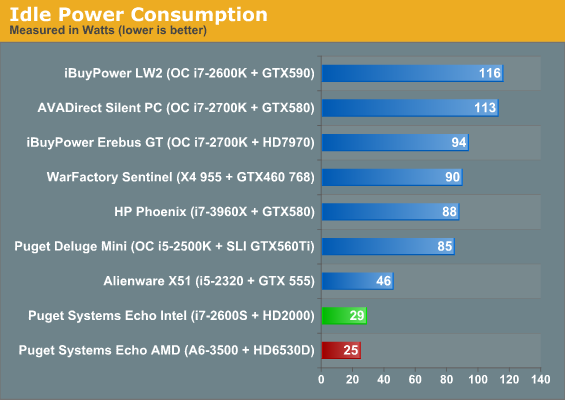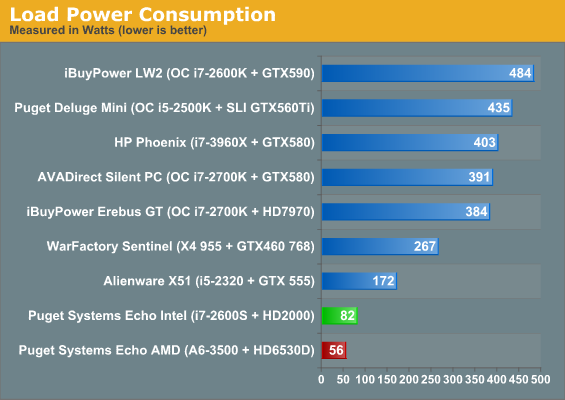Puget Systems Echo: Intel and AMD Showdown at 65 Watts
by Dustin Sklavos on March 21, 2012 2:35 AM EST- Posted in
- Systems
- AMD
- Intel
- Mini ITX
- Sandy Bridge
- Llano
- boutique
- Mini-Tower
Build Quality and Part Selection
Given the small nature of the Antec ISK-110 enclosures Puget Systems employs for their Echo I systems, it's not going to be much of a surprise that there's really only so much they can do to make build quality stand out. For what it's worth, the systems are put together as well as one can expect. Both use stock coolers from AMD and Intel, but given the low TDPs of the two processors (as well as the cramped confines of the enclosure) these coolers are never given much of a workout. Cabling is routed as well as can be expected, and Puget Systems filled both of the 2.5" drive bays. These systems really are packed to the gills.
.jpg)
This is a good time to bring up one of the ways Puget Systems distinguishes themselves from other boutiques, though. If you opt to configure a system on their site, you're going to find the number of available components substantially lower than you will from any other boutique. This has to do with their validation procedures; Puget is extremely picky about the parts they include in the desktops they ship and while I'd like to see this confidence reflected in a longer warranty than just one year, I've seen enough of their data (and their customer feedback) to corroborate their claims. It's the reason you only see Intel SSDs in their systems, for example.
It's also part of the reason why our AMD system is fighting a bit of an unfair fight, a point we brought up with Puget Systems and one they recognized. It's well known that Llano will use all the memory bandwidth it can get its hands on, while Sandy Bridge is much less sensitive. Puget hasn't qualified any 8GB DDR3-1600 DIMMs for deployment in any of their builds, and so they erred on memory capacity instead of speed. In conversations via e-mail, they even admitted this was probably a mistake in this instance. The problem is that they also don't offer any 2GB or 4GB DDR3-1600 DIMMs for the AMD-based system, either, when they do have 4GB DDR3-1600 DIMMs qualified for other builds.
As an aside, I did contact Puget Systems and ask why their parts warranty period was so limited compared to other boutiques, and their rationale is actually a fairly sound one: there's just no guarantee that the replacement parts will continue to be available for three years, given how fast hardware turns over in this industry. They don't feel a standard three year warranty is something they can in good conscience live up to, and so the three year warranty upgrade they offer is actually in place to cover the costs of offering brand new kit to replace defunct hardware should the need arise.
Heat and Noise
While I wasn't expecting too much in the way of thermal issues even with the stock cooling, I felt like noise could've gone either way when I pulled the two Echo systems out of their boxes. The side panel above the motherboard is completely ventilated, allowing fresh air to circulate inside the enclosure. That's great for cooling, but does absolutely nothing to muffle noise.
Thankfully, the circulating cool air does wonders to keep either heatsink's fan from having to work particularly hard. Neither system is actually audible while running unless you put your ear up to the open side; any kind of ambient noise in the room will muffle them. The result is that both systems never see temperatures above the low 60C on the cores, and noise is essentially a non-issue unless you're looking for a "silent" system.
Power Consumption
Most of the test results up to this point have been fairly predictable, but power consumption was a big surprise and a pretty stunning upset. Rather than build you up to it, I'll just show you.


At both idle and load, the AMD-based system beats the Intel-based one. Look at the load numbers in particular; the A6-3500 is able to beat the Intel Core i7-2600S by nearly thirty watts. I expected both to be frugal, but the A6-3500 is actually performing well under its rated wattage.


_thumb.jpg)
_thumb.jpg)
_thumb.jpg)
_thumb.jpg)
_thumb.jpg)
_thumb.jpg)








62 Comments
View All Comments
Hrel - Wednesday, March 21, 2012 - link
Seriously people, before you leave angry comments read the ENTIRE article. He addresses your complaints IN the article. As weiran says, it comes down to supply. AMD doesn't have anything better available to buy. My guess is AMD knows the only systems getting AMD chips right now are the cheapest possible systems, so they probably only manufacture a few thousand of their higher end chips; knowing anyone willing to spend that much money on a CPU will probably go with Intel. Why waste the resources on chips that will never sell? At least not for a profit. So they only keep the cheaper CPU's in stock. They have no delusions about the situation they're in; if only their fan-boys were as clear sighted.SteelCity1981 - Wednesday, March 21, 2012 - link
We know Intel has the best CPU's as far as performance on the market goes, but Wwat this did show is AMD's IGP is far better than Intels IGP. So it's really a trade off between CPU performance or Graphics performance if you only had those two options in buying a system like this. Things should get a lot better on the CPU side with AMD's APU's with Trinity using AMD's Piledriver Cores instead an old revised version of the Athlon II cores that come with Llano. And not to mention the HD 7000 series on the GPU side that will come along with it.Hrel - Wednesday, March 21, 2012 - link
Problem is you don't game on an IGP; you buy a dedicated graphics card. Also this is HALF the GPU performance of Intel. He says in the article 6 cores compared to the normal 12. So while the AMD gpu is still a little faster, not by much. And not nearly enough to matter. You aren't gonna game on an IGP, so saying AMD wins because their IGP is better for gaming is moronic. Intels chip is better at literally EVERYTHING, even video rendering.SteelCity1981 - Thursday, March 22, 2012 - link
What's moronic is the fact that yopu said AMD's IGP is a little better? Are you blind. Intels IGP is way better then intels IGP is the benchmarks clearly showed that.So people that do light gaming can't game on AMD's APU?
silverblue - Thursday, March 22, 2012 - link
This isn't meant to be a performance machine, it is meant to be a setup for 65W or less. The article points out that whilst the i7 is easily the faster of the two for CPU work (and why shouldn't it be with an extra core advantage, hyperthreading, better turbo, and 8MB L3 cache), in terms of general usage you probably wouldn't notice it that much over the A6-3500. What's more, the AMD machine uses less power and performs far better at gaming. I also feel the need to point out that the HD 2000 requires a clock speed of three times that of the HD6530D yet falls far behind. The HD3000 will help but not enormously so - put simply, only CPU bound games will do better on the Intel side (and we're talking the minority of games). Let's also not forget that Llano performs noticably better with 1600MHz RAM over the 1333 in this build.I should also mention that, due to the size of the enclosure and the limited power feed, you CAN'T really add a dedicated card to this setup. So, you have to ask yourself - do you want to use the machine for media or productivity? The AMD machine will handle both whilst costing less, whilst the Intel setup will seriously limp through games but excel at anything that doesn't require a GPU (plus it has QuickSync, of course).
Having said that, neither system is the most price friendly.
piroroadkill - Wednesday, March 21, 2012 - link
A bit cruel to pick out a cheap Llano vs a Sandy Bridge most people would be happy with in their main desktop.A8-3820 is the fastest Llano inside 65W, and would be vastly quicker than the chip tested.
I admit it's probably a pain to get hold of (I was trying to find one a while back), but it's not a fair fight without it..
Hrel - Wednesday, March 21, 2012 - link
You know who said this EXACT same thing? Dustin... IN THE ARTICLE!!!!! Gahhhh!!!! Seriously people, READ THE WHOLE DAMN THING BEFORE LEAVING A COMMENT COMPLAINING!!!Hrel - Wednesday, March 21, 2012 - link
Ok, so you absolutely cannot game on the Intel system. You can play some games on very low settings and even lower resolutions on the AMD system. Absolutely EVERYTHING else is faster on the Intel system. So, you don't WANT to game on either system. WHY would you choose the AMD system? If you want to game I'm sure a system like this is not your only system. A decent 15" gaming laptop, P151HM for instance. Any desktop that you've built or bought that has a 75 dollar graphics card in it or better. Point being if you want to game you won't do it on either of these. So unless price is all you care about, Intel it is.Ever since Intel put that video rendering engine on their CPU's, I forget what it's called right now, the one and only reason to ever consider anything AMD sells is if you play video games. The kinds of video games that require a GPU. Even then a given person might choose Nvidia over AMD. I don't want to see them go under, with the recent legal battles they've won that won't be for a while. But things don't look good. I would love nothing more than to build an AMD system, but I haven't been able to justify it since my Athlon XP. (skipped the Athlon 64 (and X2) era of CPU's). Running E8400 and GTX460 in my desktop, Sandy Bridge 2630 and GTX560M in my laptop. Each one suits all my needs in excess. I cannot see myself buying anything AMD, replacing desktop in 6-18 months. Laptops got a few years left on it. Maybe by 2015/2016 AMD will be a viable option??? Probably not:(
HW_mee - Wednesday, March 21, 2012 - link
I think the question is, why would you pay 1750$ for that Intel system?Hrel - Wednesday, March 21, 2012 - link
lol, well, I wouldn't, not even close. But I might build a similar setup myself. I've always liked the idea of a thin client as a HTPC.